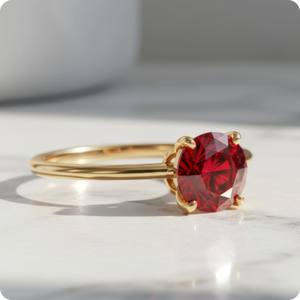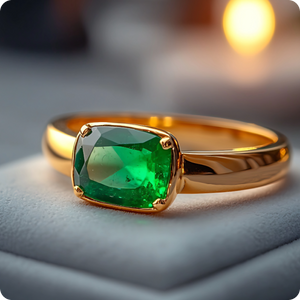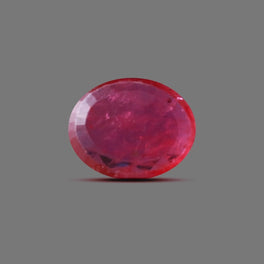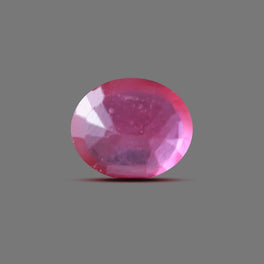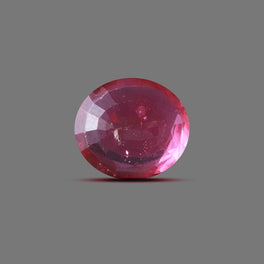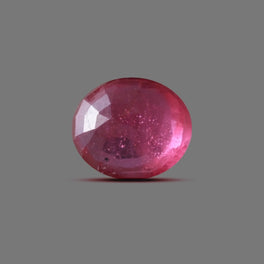Ruby, known as the "King of Gemstones," has long been prized for its rich red colour and its associations with courage, love, and wealth. It's crucial to make sure that the ruby you're purchasing is genuine, excellent, and reasonably priced, regardless of whether you're purchasing it for astrological purposes or as a gorgeous piece of jewellery.
In this in-depth guide to purchasing rubies, we'll go over the top ten items you should look for before making a purchase, as well as professional advice on how to spot genuine rubies and avoid being duped by fakes.
Top 10 Things to Check Before Buying Ruby Stone
There are certain things you need to check before getting a precious tone like ruby stone, those specifics are as follows:
1. Check the Origin of the Ruby
A ruby's worth and appeal are greatly influenced by its place of origin. Some places are well-known for generating extraordinary rubies with unparalleled beauty.
- Rubies from Myanmar, Burma The most costly and sought-after rubies in the world, they are distinguished by their fabled "pigeon blood red" hue.
- Known for their brilliant colour and excellent purity, Mozambican rubies are frequently less expensive than Burmese rubies.
- Thai rubies typically have deep red to purplish-red hues and a deeper tone.
- Lighter in tone and frequently pinkish-red, Sri Lankan rubies are nevertheless highly sought-after.
Pro Tip: Request an origin certificate from a reputable gemological laboratory. This helps determine its market value in addition to ensuring authenticity.
Read Also - Ruby Stone Rings for Men & Women
2. Assess the Colour Carefully
The most important determinant of a ruby's beauty and cost is its colour. The best rubies are highly saturated and have a pure, vivid red to slightly purplish red colour.
- The most sought-after shade is Pigeon Blood Red, which is a strong red colour with a faint blue undertone.
- Steer clear of rubies that are too bright (they may look pinkish) or too black (they may appear dull).
- Quality is indicated by even colour distribution free of zoning or noticeable blotches.
Examine the ruby in the daylight for a quick test. Low-quality rubies may appear more vivid than they actually are under artificial illumination.
3. Examine the Clarity
Tiny internal characteristics called inclusions are present in almost all natural rubies and were created during the stone's natural development. On the other hand, the more costly the stone, the fewer and less noticeable the inclusions.
- By uniformly dispersing light, certain inclusions, such as "silk" (rutile needle-like inclusions), can improve the appearance of the ruby.
- Steer clear of rubies that have black spots or big fissures that compromise their brilliance and durability.
Ruby Stone Buying Guide Tip: A ruby may be synthetic if it looks perfect and is really inexpensive. Perfectly clear natural rubies are costly and hard to find.
Read Also - Which Gemstones Can Be Worn With Ruby?
4. Understand the Cut and Shape
The colour and brilliance of a ruby are maximised when it is cut properly. Oval, cushion, round, and pear are common shapes.
- A properly sized cut guarantees that the stone will reflect light in a stunning way.
- The ruby may appear darker or less vibrant because to poor cutting.
- Weight is also impacted by cutting; in order to maintain carat weight, cutters occasionally leave rubies deep, which can lessen brightness.
Pro Tip: To make sure the ruby sparkles consistently, always compare it to various light sources.
5. Verify the Carat Weight
Particularly in greater sizes, rubies are uncommon. As the size increases, the price per carat rises considerably.
- Smaller rubies weighing less than one carat are less expensive.
- Large, fine rubies weighing more than three carats are very costly and hard to find.
- Always verify whether the quality of larger carats warrants the price increase while comparing prices.
Read Also - Ruby Gemstone Price
6. Look Out for Treatments
The majority of rubies are treated in some way to improve its clarity and colour. Certain treatments significantly lower the stone's value, while others are acceptable in the trade.
- Common and permissible if reported is heat treatment. It enhances clarity and colour without introducing extraneous materials.
- Glass-Filled Rubies: Lead glass is used to fill in fissures. These are significantly less robust and far less expensive.
- Dyed rubies: These rubies have been dyed to enhance their colour, which may eventually fade.
How to Determine Genuine Ruby Stone Advice: Always seek a competent gemological laboratory to analyse the stone and ask the seller for a treatment disclosure.
7. Check the Certification
A genuine ruby should always be accompanied by a certificate from a reputable gemological laboratory, such as:
- GIA (Gemological Institute of America)
- IGI (International Gemological Institute)
- Gubelin Gem Lab
- AGL (American Gemological Laboratories)
This report will confirm:
- Whether the ruby is natural or synthetic
- Any treatments done
- Origin (if determinable)
Read Also - Ruby vs Emerald vs Sapphire
8. Learn About Spot Synthetics and Imitations
Despite being artificial, synthetic rubies share the same chemical makeup as real rubies. Despite their potential beauty, they are significantly less valuable.
Typical imitations of rubies:
- Red spinel: chemically distinct yet similar in appearance.
- Garnet: Because of its rich red hue, garnet is frequently confused with rubies.
- Glass: An inexpensive and brittle alternative.
How to Find a Real Ruby: Use a magnifying glass to look for natural inclusions. Synthetic stones may feature gas bubbles or curved growth lines.
9. Evaluate the Seller’s Reputation
Just as significant as the ruby itself is the place where you purchase it.
- Purchase from reputable, well-established gem dealers or jewellers.
- Examine internet reviews, ratings, and comments.
- Steer clear of offers that look "too good to be true."
Ruby Stone Buying Guide Pro Tip: Find out if the vendor offers exchange or buyback options and enquire about their return policy.
Read Also - Types of Ruby Stones
10. Understand the Pricing and Investment Value
In addition to origin and treatment, the 4Cs color, clarity, cut, and carat all affect ruby prices.
- Each carat of Burmese pigeon blood rubies can sell for hundreds of dollars.
- The cost of heat-treated rubies is lower than that of untreated ones.
- Rubies that are coloured or filled with glass are not very valuable when sold.
Investment insight: Natural rubies of superior quality are uncommon and have a tendency to increase in value over time, which makes them a possible asset for investments.
Conclusion
Purchasing a ruby is an investment in energy, beauty, and history rather than just a simple purchase. The beauty and value of a fine natural ruby can endure for many generations.
By following this advice on buying rubies, you will not only be able to recognise genuine rubies but also avoid falling for fake or inferior imitations. When looking for the ideal ruby, keep in mind that your best resources are patience, research, and purchasing from reliable vendors.
A real ruby's depth, radiance, and ability to make your heart skip a beat will speak for itself.
FAQs
1. How to fid real ruby at home?
You can look for toughness, natural inclusions, and a rich, deep red colour. A ruby shouldn't scratch easily because it is incredibly hard (9 on the Mohs scale). But it's best to have a qualified gemologist evaluate it for absolute certainty.
2. How to find real ruby and avoid fake ones?
Purchase only from reputable gem dealers or jewellers, get certified by an accredited gem lab, and look at the stone under a microscope to look for natural inclusions. Steer clear of stones that appear perfect but are offered for a really low price because they are probably treated or fake.
3. Are treated rubies worth buying?
Yes, it is generally acknowledged that heat-treated rubies can still be valued provided they are revealed. Rubies that have been extensively polished or filled with glass, however, should be avoided as they are less resilient and have little market value.
4. Which origin produces the best quality ruby stones?
Burmese rubies are regarded as the best in the world, particularly those that are "pigeon blood red" in hue. In addition to their deep colour, Mozambican rubies are prized for being more reasonably priced than Burmese rubies.

 Emerald (Panna)
Emerald (Panna)
 Ruby (Manik)
Ruby (Manik)
 Yellow Sapphire (Pukhraj)
Yellow Sapphire (Pukhraj)
 Blue Sapphire (Neelam)
Blue Sapphire (Neelam)
 White Sapphire (Safed Pukhraj)
White Sapphire (Safed Pukhraj)
 Hessonite (Gomed)
Hessonite (Gomed)
 Red Coral (Moonga)
Red Coral (Moonga)
 Pearl (Moti)
Pearl (Moti)
 Cats Eye (Lahsuniya)
Cats Eye (Lahsuniya)
 Opal (Dudhiya Pathar)
Opal (Dudhiya Pathar)
 Red Garnet (Rakt Mani)
Red Garnet (Rakt Mani)
 Moonstone (Chandrakant)
Moonstone (Chandrakant)
 Carnelian (Rat-Ratua)
Carnelian (Rat-Ratua)
 Peridot (Mani Stone)
Peridot (Mani Stone)
 Green Onyx (Sulemani)
Green Onyx (Sulemani)
 Jade (Crassula)
Jade (Crassula)
 Citrine (Sunela)
Citrine (Sunela)
 Amethyst (Jamunia)
Amethyst (Jamunia)
 Aries (Mesh)
Aries (Mesh)
 Taurus (Vrushabh)
Taurus (Vrushabh)
 Gemini (Mithun)
Gemini (Mithun)
 Cancer (Kark)
Cancer (Kark)
 Leo (Sinh)
Leo (Sinh)
 Virgo (Kanya)
Virgo (Kanya)
 Libra (Tula)
Libra (Tula)
 Scorpio (Vrishchik)
Scorpio (Vrishchik)
 Sagittarius (Dhanu)
Sagittarius (Dhanu)
 January Birthstone
January Birthstone
 February Birthstone
February Birthstone
 March Birthstone
March Birthstone
 April Birthstone
April Birthstone
 May Birthstone
May Birthstone
 June Birthstone
June Birthstone
 July Birthstone
July Birthstone
 August Birthstone
August Birthstone
 September Birthstone
September Birthstone
 October Birthstone
October Birthstone
 November Birthstone
November Birthstone
 December Birthstone
December Birthstone
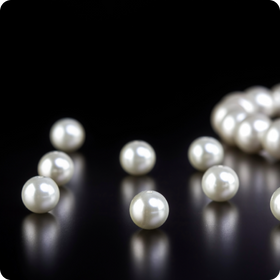
 Emerald Rings
Emerald Rings
 Yellow Sapphire Rings
Yellow Sapphire Rings
 Blue Sapphire Rings
Blue Sapphire Rings
 Ruby Rings
Ruby Rings
 Red Coral Rings
Red Coral Rings
 Pearl Ring
Pearl Ring
 White Sapphire Ring
White Sapphire Ring
 Amethyst Ring
Amethyst Ring
 Aquamarine Ring
Aquamarine Ring
 Blue Topaz Ring
Blue Topaz Ring
 Silver Jewellery
Silver Jewellery
 Gold Jewellery
Gold Jewellery
 Panchdhatu Jewellery
Panchdhatu Jewellery
 Rose Gold Jewellery
Rose Gold Jewellery
 Platinum Jewellery
Platinum Jewellery
